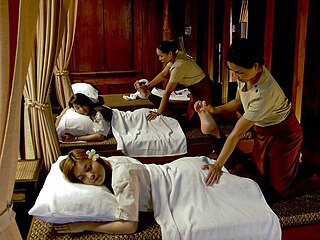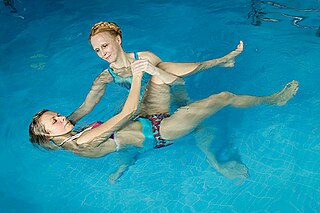
In Bamboo massage, hollow bamboo canes are used as a massage tool, either warmed or at room temperature. They can be used with or without hot stones.

In Bamboo massage, hollow bamboo canes are used as a massage tool, either warmed or at room temperature. They can be used with or without hot stones.
The bamboo cane replaces the therapist's hands, and it is used to give a deep, firm massage. The cane is held by the therapist and rolled over the muscle with the same strokes they would use with their hands. The muscle is then kneaded, which assists in the release of tension and easing of knots. Massage practitioners often use the whole arm from elbow to wrist, and the use of the bamboo cane replaces this technique.[ citation needed ]
This technique works in a very similar way to stone massage. Hands are used to work over the muscles and the cane is used to focus on knots. As the cane is used instead of the hand, various techniques and modalities can incorporate the use of bamboo canes. This can have the benefit of less stress to the practitioner's hands and arms. [1]

Massage is the rubbing or kneading of the body's soft tissues. Massage techniques are commonly applied with hands, fingers, elbows, knees, forearms, feet, or a device. The purpose of massage is generally for the treatment of body stress or pain. In European countries, a person professionally trained to give massages is traditionally known as a masseur (male) or masseuse (female). In the United States, these individuals are often referred to as "massage therapists". In some provinces of Canada, they are called "registered massage therapists."

Shiatsu is a form of Japanese bodywork based on concepts in traditional Chinese medicine such as qi meridians. Having been popularized in the twentieth century by Tokujiro Namikoshi (1905–2000), shiatsu derives from the older Japanese massage modality called anma.
Rolfing is a form of alternative medicine originally developed by Ida Rolf (1896–1979) as Structural Integration. Rolfing is marketed with unproven claims of various health benefits, is recognized as pseudoscience and has been characterized as quackery. It is based on Rolf's ideas about how the human body's "energy field" can benefit when aligned with the Earth's gravitational field.

Tui na is a form of alternative medicine similar to shiatsu. As a branch of traditional Chinese medicine, it is often used in conjunction with acupuncture, moxibustion, fire cupping, Chinese herbalism, tai chi or other Chinese internal martial arts, and qigong.

Traditional Thai massage or Thai yoga massage is a traditional therapy combining acupressure, Indian Ayurvedic principles, and assisted yoga postures. In the Thai language, it is usually called nuat phaen thai or nuat phaen boran, though its formal name is nuat thai according to the Traditional Thai Medical Professions Act, BE 2556 (2013).
Manual therapy, or manipulative therapy, is a part of Physiotherapy, it is a physical treatment primarily used by physical therapists, occupational therapists to treat musculoskeletal pain and disability; it mostly includes kneading and manipulation of muscles, joint mobilization and joint manipulation. It is also used by Rolfers, massage therapists, athletic trainers, osteopaths, and physicians.

Myofascial trigger points (MTrPs), also known as trigger points, are described as hyperirritable spots in the skeletal muscle. They are associated with palpable nodules in taut bands of muscle fibers. They are a topic of ongoing controversy, as there is limited data to inform a scientific understanding of the phenomenon. Accordingly, a formal acceptance of myofascial "knots" as an identifiable source of pain is more common among bodyworkers, physical therapists, chiropractors, and osteopathic practitioners. Nonetheless, the concept of trigger points provides a framework which may be used to help address certain musculoskeletal pain.
Lomilomi massage is a Polynesian method of kneading massage, but with overtones of the indigenous religious beliefs. The word lomilomi comes from the Hawaiian and Samoan languages. Lomi means "to knead.” The smooth flow of the strokes mimic the ocean waves. It may also mean "to take and turn, to shift" as in "the sacred shift within you that is inspired by the healing kahuna," spoken twice for emphasis.
Myofascial release is an alternative medicine therapy claimed to be useful for treating skeletal muscle immobility and pain by relaxing contracted muscles, improving blood and lymphatic circulation and stimulating the stretch reflex in muscles.

The stone massage is a form of alternative medicine massage therapy and bodywork involving the placement of either heated or cooled stones to the body for the purpose of pain relief, relaxation and therapy. There are many variations and techniques used in the application of stone massage therapy, deriving from a variety of traditional practices. Stone massages are primarily used to alleviate physical pain issues, however, are also used to promote emotional and spiritual wellbeing in practice.

Equine massage is the practice of massage on horses. Beginning in the early 1990s, it has been a growing field of equine therapy, used for both day-to-day riding and post-trauma rehabilitation. Proponents list a number of positive effects, including the improvement of movement and the reduction of pain and stress responses.
Manual lymphatic drainage (MLD) is a type of manual manipulation of the skin, not to be confused with massage, based on the hypothesis that it will encourage the natural drainage of the lymph, which carries waste products away from the tissues back toward the heart. The lymph system depends on intrinsic contractions of the smooth muscle cells in the walls of lymph vessels (peristalsis) and the movement of skeletal muscles to propel lymph through the vessels to lymph nodes and then to the lymph ducts, which return lymph to the cardiovascular system. Manual lymph drainage uses a specific amount of pressure, and rhythmic circular movements to stimulate lymph flow.

Physical therapy for canines adapts human physical therapy techniques to increase function and mobility of joints and muscles in animals. Animal rehabilitation can reduce pain and enhance recovery from injury, surgery, degenerative diseases, age-related diseases, and obesity.
Canine massage is a branch of massage therapy that promotes health in dogs. Specifically, canine massage therapy is a form of alternative therapy, the benefits of which may include relaxation, increased oxygenation, relief from pain, improved joint flexibility, and miscellaneous benefits to the immune system. It uses touch to maintain or improve both physical and emotional well-being. However, an owner should consult with a veterinarian before attempting to massage their dog themselves.
Cat massage is a practice used by veterinarians and at home by pet owners to apply massage therapy techniques to domestic cats, primarily for relieving pain and discomfort, as well as a means of strengthening the cat–human bond through intimate interaction.

Watsu is a form of aquatic bodywork used for deep relaxation and passive aquatic therapy. Watsu is characterized by one-on-one sessions in which a practitioner or therapist gently cradles, moves, stretches, and massages a receiver in chest-deep warm water.
Harold Dull (1935—2019) was an American aquatic bodyworker and poet best known as the creator of Watsu, originally developed in the early 1980s at Harbin Hot Springs, California. He is also known for his poetry, as founder of the Worldwide Aquatic Bodywork Association (WABA), and as creator of Tantsu and Tantsuyoga. Watsu is a form of aquatic bodywork in which a practitioner or therapist gently cradles, moves, stretches, and massages a receiver in chest-deep warm water for deep relaxation and aquatic therapy.
John Harvey Kellogg wrote an extensive piece on concepts revolving around the topic of massage. In his work published in 1895 called The Art of Massage, he makes it a point to discuss the history of the field. Kellogg supported pushing the idea that massage can help stimulate muscles to prevent their degradation. Also, not one category was present where the number of muscles present in men was equal to the number in women.
Marion Rosen was a German-American physiotherapist. She developed Rosen Method Bodywork and Rosen Method Movement. Under Rosen's guidance in 1980, the Rosen Institute (RI) was formed as the governing international organization that protects and sustains the quality and standards of Rosen Method. The Rosen Institute has affiliate training centers in 16 countries and has certified 1150 bodywork practitioners and 150 movement teachers.

Dorothy Stein, better known as Dr. Dot, is an American massage therapist. Dubbed the "rock and roll masseuse" and the "masseuse to the stars," Stein is known for her signature "Bite Massage" and her long-list of music industry clientele, including the likes of David Bowie, Simon Cowell, and Katy Perry.